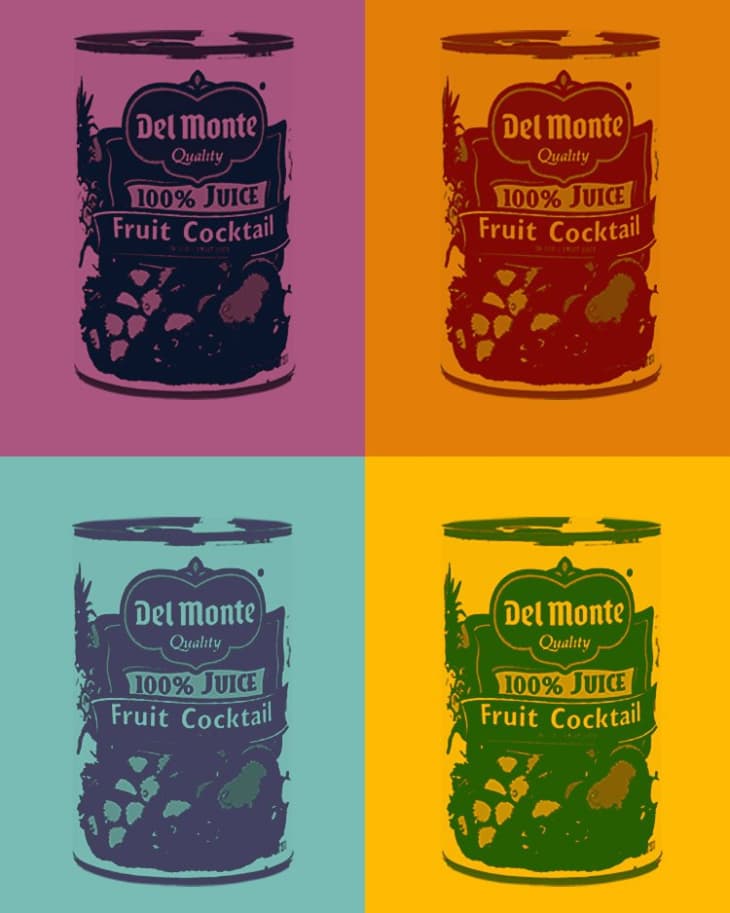Who Invented Canned Fruit Cocktail?
Canned fruit cocktail — it’s just a bunch of mushy, syrupy fruit with a few kid-friendly cherries thrown in, right? Not so fast. Fruit cocktail is actually a triumph of turn-of-the-century marketing and food technology — a perfectly packaged paean to the industrialization of our country’s food system. Here’s how it went from cookbook to can.
First There Was Fruit Salad
Fruit salad as we know it didn’t hit American tables until the mid-19th century; ambrosia, that fluffy Southern confection, dates to the mid-1800s, and Waldorf salad, which famously enrobes apples and celery in mayonnaise, was invented in 1893. If creamy ingredients weren’t involved, booze often found its way into the recipe, usually sweet wine or liqueur. (Paging Anne Shirley’s forbidden currant wine!). Thus we get the term “fruit cocktail” instead of the more generic “fruit salad” — because it really was a little bit of an aperitif or digestif. Sarah Tyson Rorer, the Martha Stewart of her day, breaks it down in her 1902 book, “Mrs. Rorer’s New Cook Book.”
“In these latter days many American cooks make a mixture of fruit, sugar, and alcohol, and serve them as ‘salad.’ These are not salads; are heavy, rather unwholesome, and will never take the place of a salad. I much prefer to call them fruit cocktails, and serve them as first course at a luncheon or a twelve o’clock breakfast; or a dessert, and serve them with the ices at the close of the meal.”
At the beginning of the 20th century, it was up to the home cook to prepare these recipes, but there was already something in the works that would revolutionize the market for fruit cocktail: the commercial canning process. Although the French had been canning food even before Louis Pasteur was able to explain why the stuff wasn’t spoiling, and companies like Heinz and Campbell’s were founded in the late 1800s, it was canny marketing tactics that brought us the brightly packaged fruit cans that still grace our supermarket aisles.
A Canny Invention
A consortium of California canning companies, whose premium brand was Del Monte, developed the canned fruit cocktail as a way to use the odds and ends of otherwise damaged fruit. (That peach with an unsightly bruise? Let’s cut around the gross part and we’ll have a few good diced bits left.) Various men lay claim to credit for the nomenclature, but the upshot is that the fruit cocktail was standardized by the almighty dollar … or, if we’re being generous, as a savvy solution to reduce food waste.
Prohibition made it, shall we say, difficult to include the cocktail portion of fruit cocktail in the recipe, but no matter — the recipe soldiered on, morphing into today’s modern form of cut fruit suspended in sugar syrup. Del Monte became the standard-bearer for the name and still holds a near-monopoly on the product.
Setting the Standard
At first, the canners used the overarching term “fruit cocktail” as any home cook would, incorporating any leftover fruit bits they could. But after the USDA’s Bureau of Chemistry became the Food, Drug, and Insecticide Administration in 1927, a standard recipe for fruit cocktail was established. As Harvard Magazine explained, “To be considered a true fruit cocktail, pears, grapes, cherries, and peaches must be included in the mix.”
Today’s USDA guidelines for fruit cocktail, developed to maintain quality benchmarks for consumers, are even more rigorous — and also include pineapple as a necessary fruit. Not only do you need to have a specific mix of fruits, but the percentage of each fruit in the cocktail mix must fall within a certain percentage by weight! Check out the full range of proportional percentages on the USDA’s site, in case you need to know how many maraschino cherries to include in your DIY version. (Similar standards exist for everything from canned cranberry sauce to fruit jellies and preserves, all in the name of consumer quality and ingredient transparency.)
And that’s why, when you look at the shelf of Del Monte’s yellow-and-green cans in the store, you’ll see there are only a few truly named “fruit cocktail.” The rest get descriptive — but not legally binding! — terms like “mixed fruit.” Don’t worry — everything’s still on the up and up with these blends. This is simply the savvy marketing way to include more cherries or maybe some papaya into the mix.
What’s the difference between all the names? Here’s a basic breakdown:
- Mixed Fruit is usually the same fruit blend as fruit cocktail, give or take a pineapple or a grape, but the size of the pieces are larger — sometimes bite-sized chunks, sometimes whole slices — than the small dice required for fruit cocktail.
- Cherry Mixed Fruit has a double whammy of extra maraschino cherries and cherry syrup instead of the usual fruit juice or neutral sugar syrup.
- Tropical Fruit Salad is a mix of papaya and pineapple, and floats the fruit in passion fruit juice.
- Citrus Salad is just that — orange and grapefruit chunks, with no pears, peaches, grapes, cherries, or pineapples to be found.
And of course, if none of these appeal to you, there’s still an orchard’s worth of canned fruit out there; Del Monte, Dole, and other fruit companies preserve and package single-fruit cans of pineapple, peaches, pears, and mandarin oranges.
